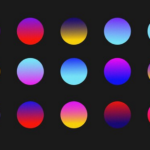Technology permeates every aspect of our modern lives, constantly evolving and reshaping our world. Central to this transformative force is not just its functionality, but also its aesthetic appeal. A key aspect of this aesthetic is color. But what color represents technology? This question is more than just a matter of preference; it’s a reflection of how technology intersects with human psychology and cultural trends.
The Dominance of Blue in Technology
Why Blue?
- Perception of Trust and Security: One of the foundational pillars of blue’s supremacy in technology is its strong association with trust and security. Blue exudes an air of stability and reliability, instantly evoking a sense of confidence among users. In today’s ever-evolving tech landscape, where personal data and sensitive information are constantly at risk, trust is paramount. Users must have unwavering faith in the devices and platforms they interact with on a daily basis. Blue, with its calming and dependable aura, plays an instrumental role in establishing and reinforcing this trust. It acts as a visual assurance that the technology they engage with is dependable and secure;
- Visibility and Clarity: Blue’s suitability for technology extends beyond the realm of psychology to the practical domain of design. In digital interfaces, where information must be conveyed clearly and efficiently, blue excels. Its high contrast against white backgrounds and dark text makes it an ideal choice for designers striving to create user-friendly experiences. Whether it’s a website, a mobile app, or any digital interface, blue enhances clarity and visibility, ensuring that information is easily discernible. This seamless user experience, in turn, fosters user satisfaction and engagement, further solidifying blue’s position in technology;
- Cultural Associations: Blue transcends geographical boundaries and holds cultural significance worldwide. It is often associated with progress, professionalism, and the future. This alignment with forward-looking ideals makes it a perfect fit for the tech industry, which is intrinsically linked to innovation and advancement. The cultural symbolism associated with blue enhances its appeal and underscores its significance in technological contexts. Blue, in essence, speaks a universal language of trust, reliability, and aspiration, making it an invaluable asset for tech companies seeking global recognition and acceptance.
Blue in Major Tech Brands
To fully grasp the ubiquity of blue in technology, one need not look any further than the branding strategies of major tech corporations. Blue overwhelmingly dominates their logos, serving as a visual testament to its preeminence in the tech world. Let’s scrutinize the use of blue in some of these corporate giants:
| Tech Company | Use of Blue |
| The iconic blue color | |
| Vibrant blue in the bird logo | |
| Combination of blue and white | |
| IBM | Enduring bold blue typeface |
These emblematic examples not only underscore the prevalence of blue but also reveal that its utilization is far from arbitrary. Rather, it is a deliberate and calculated decision by tech behemoths to convey a consistent message of trust, professionalism, and reliability. The visual cohesion among these industry leaders bolsters blue’s position as the color of choice for the technology sector.
Product Design
Blue’s influence in technology extends beyond the confines of logos to the very design of tech products themselves. Here are some notable examples:
- Smartphones: Leading smartphone manufacturers recognize the allure of blue and often offer their devices in an array of captivating blue shades. This color choice is a harmonious blend of aesthetics and user preferences. Blue smartphones not only appeal to users seeking a sleek and modern look for their portable devices but also capitalize on the psychological impact of the color, further solidifying the bond between users and their gadgets;
- Laptops: In the realm of laptops, blue has also carved out a significant niche. Blue laptops have gained remarkable popularity, catering to users who crave a chic and contemporary appearance for their computing companions. The color blue resonates with the tech-savvy audience, enhancing the visual appeal of laptops and reinforcing their role as indispensable tools in the digital age.
The Psychological Impact of Blue
The prevalence of blue in technology is not merely coincidental; it is also rooted in the psychological impact of this color:
| Psychological Impact | Description |
| Calmness and Concentration | Blue hues are renowned for their calming effect. In environments where technology is used extensively, such as offices and study spaces, this calming influence aids in maintaining focus and concentration. Users are less likely to experience distractions when surrounded by blue elements in their tech setup. |
Other Colors in the Technological Palette
While blue is predominant, other colors also play significant roles in representing technology.
The Role of Black and Gray
Black and gray, often described as achromatic or neutral colors, have an enduring presence in the technological palette. Their use extends beyond mere aesthetics; they are powerful tools in conveying specific messages and emotions to the audience.
- Sleekness and Modernity: Black and gray are frequently associated with sophistication and modernity in technology. These colors possess a unique ability to convey a sense of premium quality and cutting-edge innovation. When consumers see a sleek, black smartphone or a gray, minimalist laptop, they are more likely to associate these products with high-end, state-of-the-art technology. It’s no coincidence that luxury tech brands often opt for these colors to create an aura of exclusivity;
- Minimalism and Elegance: The minimalist appeal of black and gray goes hand in hand with the concept of elegance. In product design, less is often more, and these colors provide the perfect canvas for minimalistic aesthetics. Whether it’s the clean lines of a cutting-edge television or the polished surface of a premium camera, black and gray allow the design to speak volumes without unnecessary distractions;
- Versatility: Beyond their association with luxury and modernity, black and gray are revered for their versatility. They serve as neutral tones that seamlessly blend with various design schemes. Whether a tech device follows a futuristic, industrial, or retro-inspired design, these colors can adapt effortlessly. This adaptability ensures that the device harmoniously integrates into the user’s environment, making it a preferred choice for designers aiming for universal appeal;
- Timelessness: Black and gray are timeless choices. They transcend trends and fads, ensuring that a product doesn’t feel outdated shortly after its release. This durability in design is particularly crucial in the fast-paced world of technology, where innovation can render products obsolete within a short span. Black and gray provide a sense of longevity and reliability.
The Emergence of Neon and Vibrant Colors
While black and gray evoke a sense of seriousness and sophistication, technology also embraces the vibrancy and energy of neon and other vibrant colors. These shades have gained prominence in recent years, contributing to the ever-evolving visual landscape of tech products.
- Energy and Innovation: Bright neon colors, reminiscent of electric blue, neon green, or hot pink, are employed to signify energy, dynamism, and innovation. These hues are often chosen when a brand wants to inject a sense of excitement and forward-thinking into its products. For example, gaming peripherals, such as gaming mice and keyboards, frequently sport neon accents to reflect the exhilarating gaming experience they offer;
- Youthful Appeal: Neon and vibrant colors naturally attract younger demographics. The bold and eye-catching nature of these hues resonates with the tech-savvy and trend-conscious nature of younger generations. Whether it’s the design of mobile apps, gaming consoles, or wearables, these colors are often chosen to cater to a youthful audience, enhancing the product’s appeal and relatability;
- Personalization and Brand Identity: Neon and vibrant colors offer a unique opportunity for personalization and brand identity. In a crowded market, where differentiation is key, brands leverage these colors to create a distinct visual identity that sets them apart from competitors. Recognizable color schemes become part of a brand’s DNA and help in building strong brand recognition;
- Psychological Impact: The psychological impact of neon and vibrant colors cannot be understated. They evoke emotions ranging from excitement and enthusiasm to optimism and positivity. These emotions can significantly influence a consumer’s perception of a product and brand. Thus, the choice of neon and vibrant colors is a strategic decision for companies aiming to create a lasting impression on their audience.
The Evolution of Color Trends in Technology

The world of technology has undergone a remarkable transformation in terms of color trends. Understanding this evolution is crucial for designers, manufacturers, and consumers alike. Let’s take a detailed look at the past and current color trends in technology.
Past Trends
In the early days of technology, color choices were quite limited, with a predominant focus on neutral hues such as beige and gray. These choices were primarily driven by practical considerations rather than aesthetic preferences. Here’s a closer examination of past color trends:
- Neutrals Rule: Beige and gray were the reigning champions of tech colors. These neutral tones were considered safe and unobtrusive, making them suitable for a wide range of products, from early personal computers to office equipment;
- Functional Over Fashionable: The primary objective behind these color choices was functionality. Beige and gray were less likely to show dirt or wear and tear, which was a practical consideration in a world where technology was still finding its footing.
Current Trends
As technology has advanced, so has the color palette used in the industry. Today, we witness a significant shift towards more personalized and diverse color choices, reflecting individual styles and preferences. Let’s delve deeper into the current color trends in technology:
- Personalization and Diversity: In the current technological landscape, personalization is key. Consumers now expect a range of color options to suit their individual tastes and lifestyles. Devices like smartphones, laptops, and even gaming consoles offer an array of colors to cater to diverse preferences;
- Brand Identity and Recognition: Companies have realized the importance of color in building brand identity and recognition. They carefully select distinctive color schemes that not only represent their brand but also resonate with their target audience. For instance, Apple’s iconic white and silver color scheme is instantly recognizable and synonymous with their products;
- Emphasis on Aesthetics: Aesthetics have become a significant driving force in color choices. Sleek and visually appealing designs are now a standard expectation among consumers. This focus on aesthetics extends to software and user interfaces as well, with attention to color schemes and graphical elements.
The Influence of Functionality on Color Choice
The choice of colors in technology goes beyond mere aesthetics; it also has a profound impact on functionality and user experience. Here are two key areas where functionality influences color choices:
| Aspect | Role of Color in User Interface Design |
| Visual Hierarchy | Color is crucial for establishing visual hierarchy. Important elements like buttons or notifications are often highlighted with contrasting colors to attract attention. |
| Consistency | Consistent color usage across UI elements aids in user understanding and navigation. It allows users to quickly identify common functions or areas. |
| Accessibility | High contrast between text and background is vital for readability, aiding users with visual impairments. Guidelines like WCAG suggest specific contrast ratios. Thoughtful color schemes accommodate color blindness, ensuring clarity and distinction for all users. |
Conclusion
The question of what color represents technology is not confined to a single hue. While blue stands out as the most prominent color in the tech world, the spectrum of colors used in technology is as diverse and dynamic as the field itself. From the trust and clarity of blue to the modernity of black and gray, and the vibrant energy of neon colors, each color plays a pivotal role in shaping our perception of technology and its place in our lives. As technology continues to evolve, so will the colors that represent it, painting a vivid picture of innovation and progress.
FAQ
Q1: Why is blue considered the color of technology?
A1: Blue is seen as trustworthy, clear, and culturally associated with progress, making it a popular choice in the tech industry.
Q2: Are there other colors that represent technology?
A2: Yes, besides blue, colors like black, gray, and vibrant neon hues also play significant roles in technology representation.
Q3: How do color trends in technology change over time?
A3: Color trends in technology have evolved from basic neutrals to a wider range, including personalized and vibrant colors, reflecting the dynamic nature of the tech world.
Q4: Does the choice of color in technology impact its functionality?
A4: Absolutely. In user interfaces, color choice can affect usability, accessibility, and the overall user experience.




